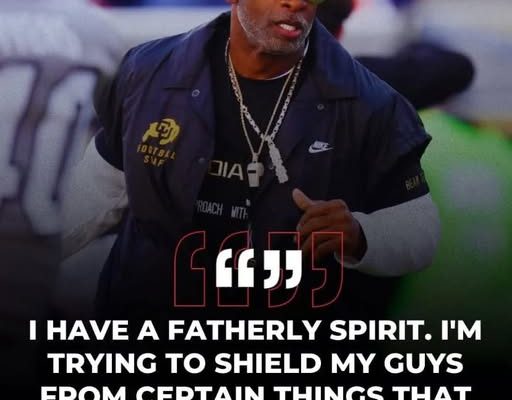In the aftermath of the shocking 52–17 defeat suffered by the Colorado Buffaloes at the hands of the Arizona Wildcats, head coach Deion Sanders made a dramatic decision: none of his players or assistant coaches would address the media. Instead, Sanders himself assumed full responsibility for the collapse, and declared that if anyone were to be held accountable, it would be him—“Come at me,” he said. Yahoo Sports+3CBS Sports+3Fox News+3
From the moment the final whistle blew, the signals were unmistakable. Colorado trailed 38–7 by halftime, committed five turnovers and 14 penalties in the game, and the rout marked back‑to‑back blowout defeats for a program that only a year ago looked on the upswing. ESPN.com+2The Washington Times+2 When Sanders stepped to the podium, he made clear the change in protocol: “No one will be available tonight. It’s on me.” Yahoo Sports+1
This represents a dramatic shift in culture and accountability within the program. Traditionally, after a blowout loss, players and assistants become accessible to reporters, offer apologies, reflect on performance lapses and perhaps commit to improvement. Instead, in this case, the athletes were shielded completely. The players did not face questions, the assistants remained silent, and the message was sent loud and clear: this is the head coach’s responsibility. But why such an approach?
One interpretation is that Sanders, widely known for his brash public persona and intense recruiting vision when he arrived in Boulder, decided to protect his younger roster from what he saw as unfair scrutiny or external distraction. The season has not gone as envisioned: after a 9–4 and 7‑2 Big 12 finish last year, the Buffaloes sit at 3–6 overall and 1–5 in conference play following this latest calamity. ESPN.com+1 With morale under pressure, Sanders may have chosen to halt external noise and let internal work proceed without public commentary from his players.
In his own remarks, Sanders repeatedly emphasized that the blame lies with him. He implored the media: “Don’t attack the coordinators. Come at me. Don’t attack the players.” CBS Sports+1 He also dismissed talk of his players having mentally checked out. Asked if his team had quit on him, he declared: “I know a quitter when I see one. I haven’t seen that.” ESPN.com+1 Through these comments, Sanders sought to draw a line between the team’s effort and its execution. The message: the players are still in, the issue is systemic and coaching‑led rather than a failure of heart.
However, the absurdity of the performance cannot be ignored. Four touchdown passes were surrendered by Colorado’s defense. The penalty count, the turnovers, the inability to mount any meaningful rally—all point to more than just a bad night. They signal a program in deeper trouble than might have been anticipated. Fox News+2CBS Sports+2 Against this backdrop, Sanders’ decision to silence his roster can be read not only as protective but also as strategic: by refusing to offer names, excuses or shifting blame, he maintains firm control over the narrative. He frames the issue as “my fault,” thereby preserving the players from becoming scapegoats and giving himself the runway to attempt internal fixes.
Yet, such a move also comes with risks. In modern college football, transparency and media engagement are part of the ecosystem. Players often become the face of the program, voices that reach recruits, fans and boosters alike. By pulling his players away, Sanders lowers their public profile, potentially limiting their opportunity to build personal brand value, media experience, and public accountability. In doing so, he implicitly accepts that the institution—and he himself—will absorb whatever reputational costs follow. For recruits and stakeholders, seeing no player commentary after such a loss may raise questions about internal morale, player‑voice, and upward momentum.
Furthermore, the optics of the decision may signal to all observers that this is a program under duress. When the head coach steps in front of the cameras and says “this is all on me,” it acknowledges a failure of leadership and execution. It projects a message that things have gone off track—and the chance is now about salvaging rather than celebrating. For a program that once seemed poised for breakthrough under Sanders’ swagger and media‑friendly presence, this is a sobering turn.
The timing of this action is critical. With only three Big 12 games remaining and bowl eligibility increasingly slipping away, the margin for error is vanishing. The players are still young; many of the star transfers and high‑profile recruits of the previous two seasons have either moved on or entered the NFL draft. The expectations surrounding Colorado under Sanders were ambitious, if not bold, and a 3–6 record in his third year threatens to tarnish the narrative of rapid upward trajectory. In that context, controlling the message by limiting media access may be as much a crisis‑management tactic as a philosophical one.
Sanders’ legacy at Colorado is still being written. When he arrived, he brought with him charisma, national attention, and an expectation of instant transformation. In the early going, the Buffaloes showed flashes—hearts of the program were revitalised, recruits took notice, and fans bought into the vision. But sustained success in Power Five football demands consistency, depth, execution and adaptability. The latest collapse and ensuing media blackout may suggest that the honeymoon has ended and the tougher part of the rebuild is well underway.
The decision to bar players from media access also underscores a tension between performance and perception in sports administration today. On one hand, limiting access might help players focus, shield them from negative narratives, and reduce distractions. On the other hand, it may foster an environment of isolation or silence, where learning from public post‑game reflection becomes harder. Coaching staffs often rely on players processing external scrutiny to galvanize change internally; removing that layer could blunt a potential catalyst for urgency, unless other processes are already tightly in place.
From a leadership lens, Sanders’ action reflects a style that is both bold and unapologetic. By telling the world that he alone will take the heat, he exhibits ownership. But it also creates a burden: failure becomes his to own, but redemption must come through him too. The athletes are off the hook publicly for now—but only temporarily. Ultimately, what matters most is their performance on the field, their growth within the system, and their collective response. If wins do not follow, questions will circle back.
While the focus now is on internal adjustments—practice quality, discipline, execution, turnover avoidance, penalty reduction—it remains to be seen whether this media moratorium is a short‑term shock tactic or a longer‑term shift in culture. Will Colorado players eventually engage with reporters again only once results improve? Or will the program redefine its media strategy entirely under Sanders’ direction? Either way, this moment may mark a turning point in how the Buffaloes conduct themselves publicly.
For the fans, alumni and boosters of Colorado football, the visible fallout is unsettling. The program has tasted promise; this season’s free‑fall is disorienting. But Sanders’ move also signals that he is not content to let the players carry the blame. He is willing to accept it. That may win some sympathy, but unless it translates into better performances, sympathy will be fleeting. In college sports, results always speak loudest.
In closing, the 52‑17 loss to Arizona was more than just a lopsided defeat—it has become a symbolic nadir. By shielding his players from the media, Deion Sanders has altered the usual post‑mortem routine. He has signalled that the mechanism is broken, that the root cause lies with him, and that the process must change from within. Whether that shift ultimately leads to redemption for the Colorado Buffaloes remains to be seen. For now, the shot across the bow has been fired—not at the players, but at himself and the program he leads.



